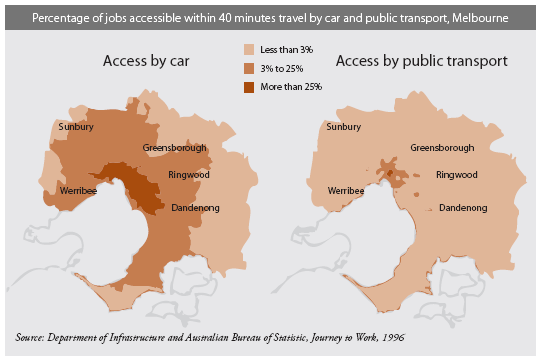Undeterred, to approach its goals, the government has set out a Plan (Meeting our transport challenges). Over the coming decade, this allocates for Melbourne about $6,035 million for transit and $2,155 million for roads.
Thus, the car, comprising 92 per cent of the motorised market and contributing a massive net revenue in taxation, is to be outspent almost 3:1 by transit which currently has 8 per cent of the market and in the widely optimistic forecast of The Plan might have 15 per cent.
Transit’s ability to meet consumers’ needs
In spite of public transport benefiting from massive subsidies, the coverage of its ability to carry people to their destinations quickly is highly restricted. Add to this the convenience in leaving home or work when you wish, and comfort, and the task confronting transit becomes colossal.
Advertisement
The problem is graphically demonstrated by the government in the following map of the accessibility of jobs in Melbourne by car and transit.

The map is designed as ammunition for those seeking to boost transit spending, but actually it merely shows the enormity, the impossibility, of the task of forcing more people off cars and on to transit. A casual examination of the dark and light areas illustrates the magnitude of the task in reversing the on-going trend away from transit uses.
Compared to public transport, people find cars to be more convenient and lower cost. Importantly, transit finds itself on the wrong side of history. It can only operate effectively in urban conditions and only really effectively in urban areas with high densities and concentrated origin and destination points. A rule of thumb is that, to be commercially viable, rail-based systems require 40,000 people per square kilometer and express bus systems 25,000.
Melbourne has an average density of 1,500 and reaches a maximum of 5,500 only in the densest suburb. Transit’s disadvantages are compounded by the changing nature of cities themselves. Less than 50 years ago, 55 per cent of Melbourne’s jobs were in the central area. Today, it is 28 per cent and only 10 per cent work in the area we call the Central Business District. Work locations, which were once dictated by the availability of mass transit and tended to be located in the central areas of the city, are now becoming far more dispersed.
This is partly due to the nature of work itself - far more is undertaken at diffuse locations because of a reduction in factory sizes, telecommunications advances and a shift towards services that do not require traditional employee concentrations.
Advertisement
It also reflects people’s preferences - a great many people, even those with access to free transit travel, choose to use their cars because they are more convenient.
Transport as a service
Transport is a derived demand. In other words, not many people get in their car or hop on a tram just for the pleasure of doing so. People use transport to get from A to B. They wish to do so as quickly as possible with constraints on price and comfort, and so on. This did not appear to have been a priority for the Victorian Government that identified problems of transport in Melbourne 2030, which instead focused on equity, pollution and the like.
The root cause of any transport problems we have is this determination to give people what the government and certain elites think is good for them rather than what they themselves want. Such arrogant dismissal of people’s own preferences is an endemic problem with urban planning.
Discuss in our Forums
See what other readers are saying about this article!
Click here to read & post comments.
91 posts so far.